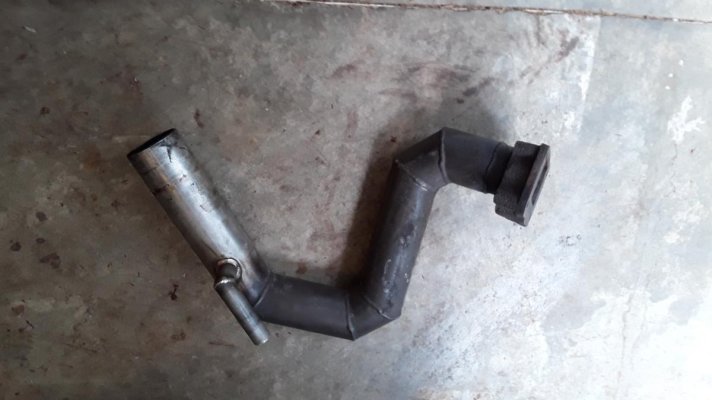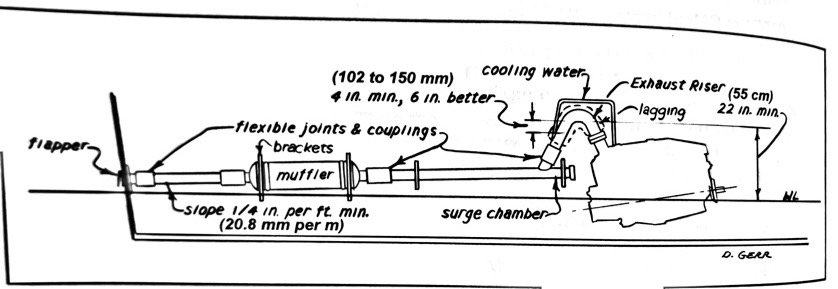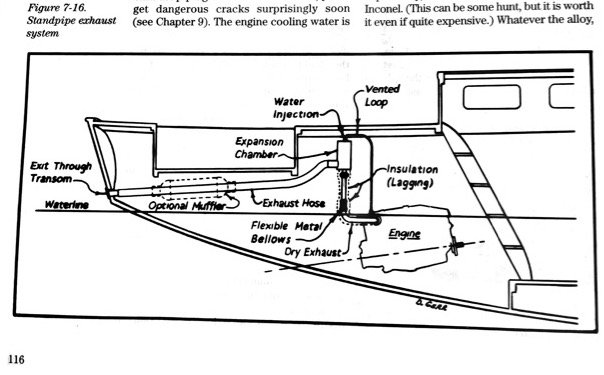Tazling
Veteran Member
- Joined
- May 17, 2021
- Messages
- 74
- Vessel Name
- DARXIDE
- Vessel Make
- Grand Banks 32
I'll try to get some good pics of this and update later, because it's hard to describe, but my FL 120 has a non-standard exhaust system that looks pretty strange to me....
From the back of the engine just at water injection point emerges a monster stainless steel pipe maybe 4 inch diam. It wanders off to port, meeting up with an equally monstrous circular flange (like something off a submarine) also of SS, with quite a number of big fat bolts holding it together. After that, there's a pipe of some material or other (iron at a guess?) wrapped in FG cloth held on by spiraled wire. That pipe then goes into a complicated looking water muffler thing -- stainless also? -- which is mounted high up under the deck, and then it looks like (phew) conventional black exhaust hose goes aft to the exhaust port on the transom.
It's an odd looking setup and has clearly reached its best-by, 'cos I'm seeing stray carbon under the monster flange, also rusty drip marks and corroded, spongy bits of wire that have fallen off. I think it's really on its last legs. Also the spiffy SS pipe exiting the engine is pinholed at one welded angle -- it's been patch welded, but the patch is failing, and I've JB-welded over it just to get through the summer. That stopped the pinhole seep... But clearly Something Must Be Done.
So I was wondering if any of y'all with FL-120s -- preferably a GB32 but a 36 would probably be helpful too -- might be willing to share pics of your exhaust systems so I can see what variations there are, and what I might replace this impressive but aging work of art with.
From the back of the engine just at water injection point emerges a monster stainless steel pipe maybe 4 inch diam. It wanders off to port, meeting up with an equally monstrous circular flange (like something off a submarine) also of SS, with quite a number of big fat bolts holding it together. After that, there's a pipe of some material or other (iron at a guess?) wrapped in FG cloth held on by spiraled wire. That pipe then goes into a complicated looking water muffler thing -- stainless also? -- which is mounted high up under the deck, and then it looks like (phew) conventional black exhaust hose goes aft to the exhaust port on the transom.
It's an odd looking setup and has clearly reached its best-by, 'cos I'm seeing stray carbon under the monster flange, also rusty drip marks and corroded, spongy bits of wire that have fallen off. I think it's really on its last legs. Also the spiffy SS pipe exiting the engine is pinholed at one welded angle -- it's been patch welded, but the patch is failing, and I've JB-welded over it just to get through the summer. That stopped the pinhole seep... But clearly Something Must Be Done.
So I was wondering if any of y'all with FL-120s -- preferably a GB32 but a 36 would probably be helpful too -- might be willing to share pics of your exhaust systems so I can see what variations there are, and what I might replace this impressive but aging work of art with.








